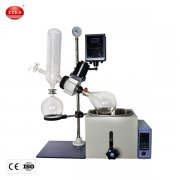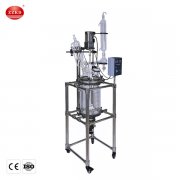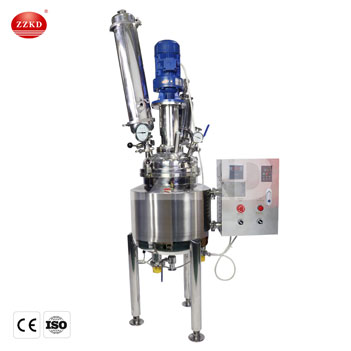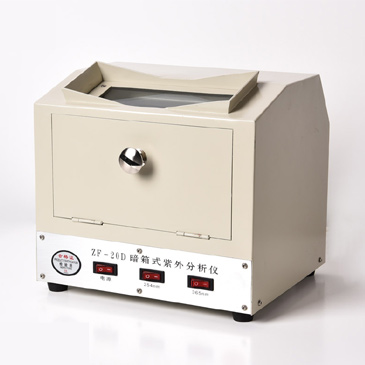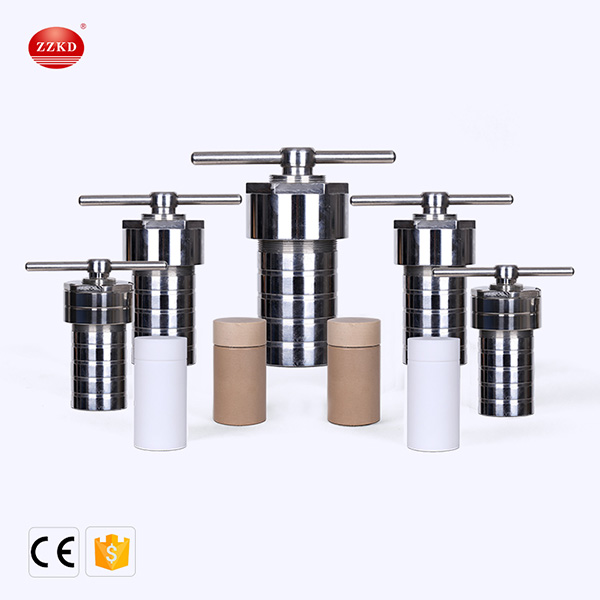The
hydrothermal synthesis reactor is also called high pressure hydrothermal autoclave reactor. We are professional lab equpiment manufacturer, hydrothermal synthesis reactor is one of our main products and exports to dozens of countries.
It is mainly used for the treatment and digestion of heavy metals, agricultural residues, food, sludge, rare earths, aquatic products, organic matter, etc. It is a necessary equipment for the determination of trace elements.
1.Working principle of hydrothermal synthesis reactor
The hydrothermal synthesis reactor is to use high temperature and high pressure aqueous solution under certain temperature and pressure conditions to dissolve those insoluble or hardly soluble substances under atmospheric conditions, or react to form the dissolved product of the substance. After controlling the temperature difference of the solution, convection is generated. It forms a saturated state and precipitates and grows crystals.It can be used in the preparation of nanomaterials, compound synthesis, crystal formation and other fields, and can also be used in small-dose synthesis reactions. It is a small stainless steel reactor that is very commonly used in colleges and universities.
2.Precautions for the use of hydrothermal synthesis reactor
(1)Pour the reactant into the PTFE liner or PPL liner, and ensure that the feed coefficient is less than 80%.
(2)Make sure the position of the bottom gasket of the kettle body is correct (the convex side is facing downward), then put in the PTFE bushing or PPL bushing and the upper gasket, first tighten the kettle cover, and then use the afterburner to tighten the kettle cover until it is tightened .
(3)The hydrothermal synthesis reactor is placed in the heater, and the temperature is raised to the required reaction temperature according to the specified heating rate. (Less than the specified safe use temperature).
(4)After confirming that the temperature in the kettle is lower than the boiling point of the reactants, the lid of the kettle can be opened for subsequent operations.When the temperature is lowered after the reaction is over, it must be operated strictly in accordance with the specified cooling rate, which is conducive to safety and the service life of the reactor.
(5)After confirming that the temperature in the kettle is lower than the boiling point of the reactants, first use a screw to loosen the kettle cover, and then open the kettle cover.
(6)The hydrothermal synthesis reactor should be cleaned in time after each use to avoid corrosion.Particular attention should be paid to cleaning the seals of the kettle body and the kettle cover line, and prevent them from being damaged by bumps.
3.The cleaning method of the inner lining of the hydrothermal kettle
(1)Choose different cleaning methods according to the different reaction media of the hydrothermal synthesis reactor.
The catalyst of the hydrothermal synthesis reactor is a silicon system, and after use, add an appropriate amount of hydrofluoric acid or alkali to heat and wash;
In the case of the silicon metal system, it is different from the acid dissolved in the reaction. For example, hydrochloric acid requires sulfuric acid (concentrated nitric acid and concentrated hydrochloric acid in a three to one ratio).
For example: Dissolve potassium permanganate in water after use, then add 3-5ml of concentrated hydrochloric acid, put it in a hydrothermal synthesis reactor and seal it, react at 180℃ for 5-10 hours, and it can be cleaned.
(2)The cleaning method of the inner lining of the hydrothermal synthesis reactor commonly used in the laboratory.
Wash with sulfuric acid.
After the experimental reaction is over, add about 1:5 of the mixed solution of nitric acid and water in the inner tank (Hydrothermal autoclave reactor with teflon chamber 100ml), then heat to 180°C and maintain for about 12 hours. These data are only for reference, and the actual operation is mixed The proportion of the solution, temperature, etc. can be determined according to the specific conditions of the experimental reaction. But the disadvantage of this method is that it will make the experiment reproducibility worse.
Boil with oxalic acid solution for 6 hours at a temperature of about 160 degrees, depending on the experimental situation.
Use hydrofluoric acid or ethanol to heat the reaction cleaning, or use other strong acids.
Note: It is strictly forbidden to use a low boiling point system that is easy to explode in the hydrothermal synthesis reactor. When the hydrothermal kettle is used up, the inner lining and outer jacket are separated and dried at 50°C.

 Products
Products





